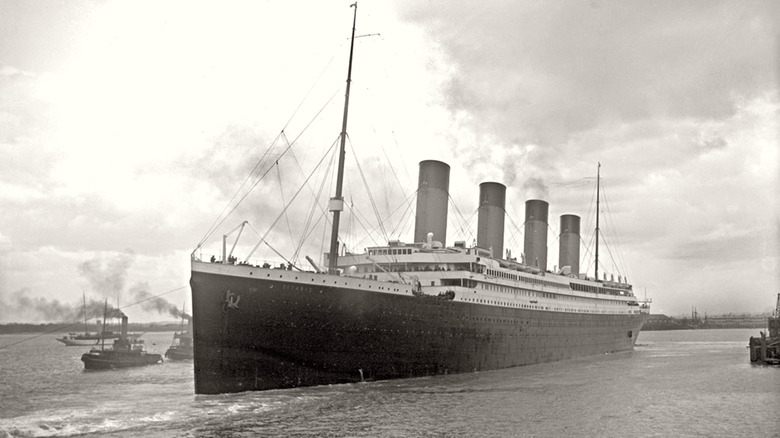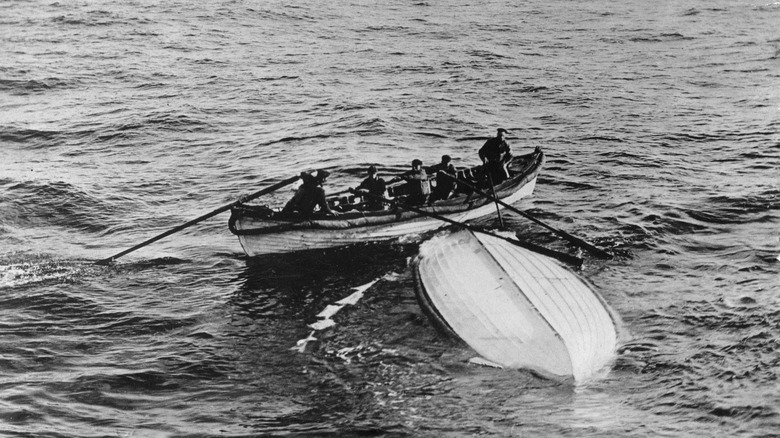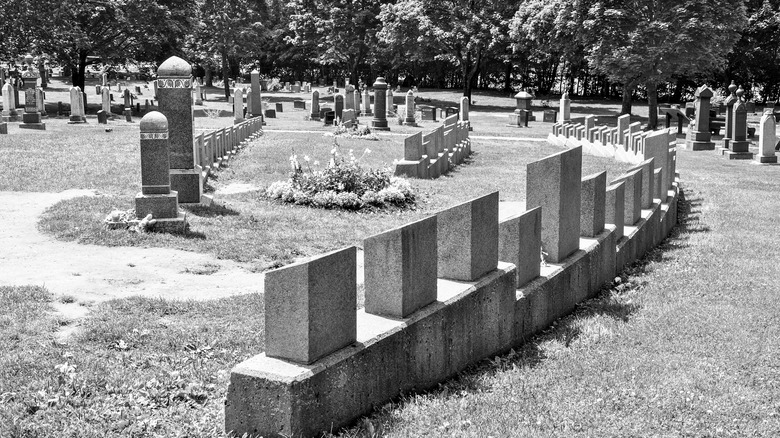Here's How Many Dead Bodies Have Been Recovered From The Titanic
The sinking of the RMS Titanic is one of the most famous stories of maritime disaster, thanks in part to James Cameron's 1997 movie "Titanic" starring Leonardo DiCaprio and Kate Winslet. The RMS Titanic was a luxurious steamship that boasted a swimming pool, elevators, a dining saloon, and even a gym, among other stellar features. These facilities were decked with fine furniture and state-of-the-art equipment for the time. The second- and third-class accommodations weren't bad either, and provided entertainment areas and comfortable rooms for those who couldn't afford first-class tickets, per BBC.
Just before midnight on April 14, 1912, the Titanic struck an iceberg, which tore into the side of the ship, causing compartments to rupture and flood with water. It would only be a few hours until the Titanic would be completely swallowed by the ocean on the early hours of April 15. The Titanic had a total of 20 life boats, more than the required number by the board of trade, but definitely not enough to rescue all passengers and crew (via Britannica). The ship had approximately 2,200 aboard, while the 20 life boats could only carry 1,178 people. To add to that, the evacuation was disorganized because of panic, and some lifeboats were released without even reaching full capacity. All in all, only 705 people were able to escape the sinking ship. The rest died in the frigid waters of the Atlantic, while others went down with the Titanic when it sank to the bottom of the ocean.
Body recovery efforts
The CS Mackay-Bennett, from Halifax, Nova Scotia, was tasked to retrieve dead bodies following the sinking of the Titanic. Halifax was the major port closest to the location of Titanic's sinking, and even then, it took four days for the ship to reach the site. According to Mental Floss, the Mackay-Bennet was loaded with ice, wooden coffins, and embalming fluid. The ship's captain, Frederick Harold Larnder, described the scene and said that the bodies looked "like a flock of seagulls." Recovery crew went out on boats to recover the bodies that were floating in the ocean.
The Mackay-Bennett spent a week searching the site and surrounding areas for bodies. After their efforts, they were able to recover 306 victims. Three other ships from Halifax were sent to the site and they were able to recover 22 additional bodies, and other steamers that just happened to pass by the site recovered five dead bodies, per Maritime Museum. The rescue ship Carpathia recovered four, according to the Nova Scotia Maritime Museum. Of the 300-plus bodies recovered, 119 were buried at sea, for a couple of reasons. Some were found after the embalming fluid ran out, and other bodies were beyond recognition. According to The Sun, the bodies that were buried at sea were wrapped in cloth and then strapped to weights to make them sink to the bottom of the ocean. Roughly 1,500 people died when the Titanic sank, and of that number, approximately 1,160 bodies were never recovered (via The New York Times), making the vast ocean their final resting place.
Where they're buried
After the recovery efforts, the ships carrying the dead bodies docked at Halifax. Curious onlookers were gathered at the docks to watch as the bodies were transported from the ship to the waterfront. Per CBC, Halifax was chosen as the location best suitable for bringing the dead, as the bodies could easily be transported from the location to other cities by train or ship if needed, depending on whether the family of the victim could afford the costs. Halifax mourned the loss of lives by putting black crepe on windows and flying flags at half-mast.
Of the bodies that were recovered, 150 were buried in three different cemeteries in Halifax. Those who were identified were given headstones by their families, while unidentified victims had simple headstones saying they died on the Titanic. According to Reuters, more than 25% of those buried in Halifax remain nameless, but that doesn't stop citizens from offering tributes by leaving items by the graves of the anonymous victims.
In 2019, BBC reported that a Titanic expert, Bill Willard, was attempting to test the remains of the unknown individuals in order to finally identify them. While the British Titanic Society approved the proposal, some graveyard authorities where victims are buried refused the test, saying that the dead should just be left to rest in peace instead of having their graves disturbed. One unnamed victim was identified in 2001 through testing and was revealed to be Sidney Goodwin, who was just 19 months old when the Titanic sank.


